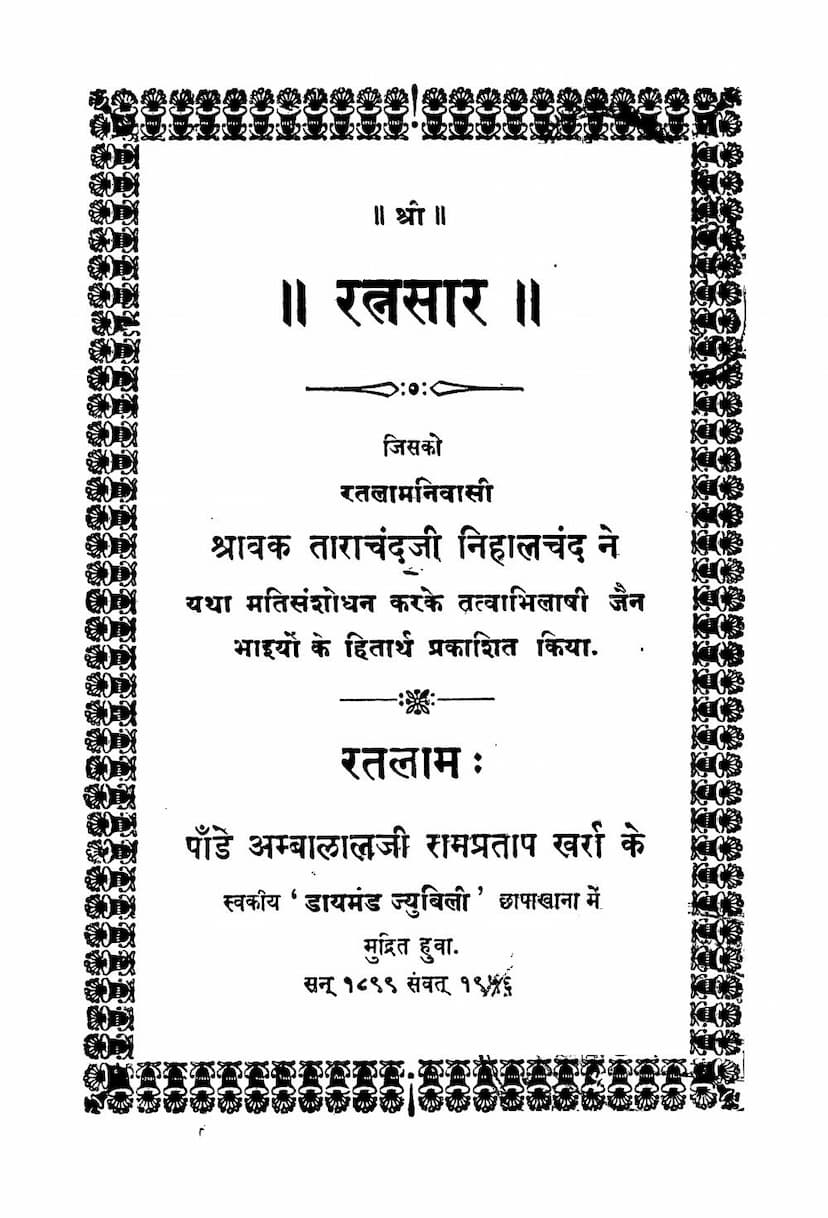Ratnasar
Added to library: September 2, 2025

Summary
Here's a comprehensive summary of the Jain text "Ratnasar" by Tarachand Nihalchand Shravak, based on the provided text and catalog link:
Book Title: Ratnasar (रत्नसार) Author(s): Tarachand Nihalchand Shravak (ताराचंद निहालचंद श्रावक) Publisher: Tarachand Nihalchand Shravak (ताराचंद निहालचंद श्रावक) Year of Publication: 1899 (Samvat 1956) Printing Press: Diamond Jubilee Press (डायमंड ज्युबिली छापाखाना) of Pandey Ambalalji Rampratap Kharra. Location: Ratlam (रतलाम)
Overview:
"Ratnasar" is a collection of 304 questions and answers, compiled to elucidate the profound meanings of various Jain scriptures. The compiler, Tarachand Nihalchand Shravak, published this work for the benefit of Jain brothers seeking to understand spiritual truths. The author is unknown, but the style and depth of the questions suggest it was composed by a highly intelligent and knowledgeable Acharya well-versed in the Dravyanuyoga (the branch of Jain philosophy dealing with substances and their properties).
Compilation and Editing:
The manuscript from which this edition was printed was found to be impure, with numbering errors in the questions (which were later corrected). Despite efforts to find a purer copy, none were successful. However, due to the earnest requests of the Jain community, the book was printed from the available manuscript. Later, Acharya Shrimad Vijay Rajendrasurishwar Muni Maharaj kindly sent a copy from the Shivganj Bhandar, which greatly aided in the correction process. Even with the second copy, both manuscripts had imperfections, preventing a complete and thorough revision. In many places, the original handwritten text had to be retained as is, due to the compiler's inability to fully grasp the intended meaning and to avoid deviating from the original author's intent.
Content and Structure:
The book is structured as a series of questions covering a wide spectrum of Jain philosophy and practice. The table of contents reveals the extensive range of topics discussed. Some of the key subjects covered include:
- The glory of the speech of the Vitaraags (the Tirthankaras).
- The importance of listening to and understanding the core principles of scripture.
- The qualities that lead to good fortune and the company one should seek or avoid.
- The nature of sin, merit, and impermanence in the soul.
- The origin of Dharma, merit, and sin.
- The principles of Jain Dharma and the nature of sermons.
- The significance of various virtues and qualities like forgiveness, humility, truthfulness, and contentment.
- The meaning of terms like Heya (to be renounced), Gneya (to be known), and Upadaya (to be accepted).
- Different types of meditation (Kaussarg) – both material (Dravya) and spiritual (Bhava).
- The nature of impurities and how to overcome them through virtuous qualities.
- Different types of wrong beliefs (Mithyatva) and their eradication.
- The essence of the Nine Tattvas (Nav Tattvas) and Six Substances (Shat Dravyas).
- The nature of cause and effect in karma (Bandh, Uday, Udiraṇa, Satta).
- The characteristics of spiritual contemplation (Bodha) and equanimity (Samadhi).
- The meaning of spiritual fervor (Samveg) and detachment (Vairagya).
- The role of charity (Dan), ethical conduct (Shīl), penance (Tap), and spiritual disposition (Bhava) in spiritual progress.
- Obstacles to meditation.
- The meaning of various terms and concepts like Nishkepa, Paryaya, Naya, and different types of death.
- The characteristics of different types of souls, including those in good and bad destinies.
- The nature of happiness and suffering, and their causes.
- The principles of Jainism, including the doctrine of Syadvada (multi-faceted truth).
- The nature of different types of ascetics and their vows.
- The characteristics of various stages of spiritual development (Gunsthanas).
- The meaning and significance of the Three Jewels (Ratnatraya) – right faith, right knowledge, and right conduct.
- The different types of vows and their observance.
- The nature of sustenance (Ahar) and vital life-forces (Prana).
- The causes and effects of attachment and aversion.
- The path to liberation (Moksha).
- The importance of knowledge (Gyan), faith (Darshan), and conduct (Charitra).
- The role of non-violence (Ahimsa) and compassion (Daya) in Jainism.
- The descriptions of the universe, heavens, hells, and the various states of existence.
Purpose and Significance:
"Ratnasar" aims to provide clear and concise answers to a wide array of spiritual questions, making complex Jain philosophical concepts accessible to the common Jain. By presenting information in a question-and-answer format, the book facilitates learning and understanding for those seeking to deepen their knowledge of Jainism. The compiler's intention was to serve the spiritual needs of the community and encourage further study of Jain scriptures.
The book serves as a valuable resource for understanding Jain philosophy, ethics, and practices, offering insights into the path towards spiritual liberation as taught in Jainism.